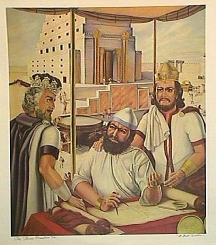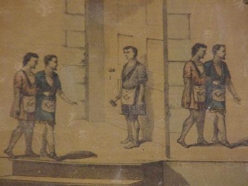Most of the
information on this page was taken from a series of booklets published
by the Grand Lodge of Connecticut.
Excerpted
from Bay View Lodge No.120, Connecticut A.F.&A.M.,
Niantio, CT. Used with permission.
The true origins of Freemasonry are clouded in both history and mystery.
"Modern" Freemasonry dates back to the forming of the first
Grand Lodge in England in 1717, though historical analysis shows Masonry
to be much older. Written records of modern Masonry's precursors date
back to the 14th century, while other aspects of Masonry date back to
thousands of years B.C.
 There is much speculation as to the
origins of Freemasonry. The earliest known use of the Square and
Compasses symbol was its carving in an altar from 3800B.C. There is
evidence that an elementary type of craft association existed as early
as the time of King Solomon's Temple (about 1012 B.C.). That structure
was the architectural masterpiece of its day; and because of the
relationship between those early masons and the building of that
spiritual edifice, Masonic tradition is rich in references to its
construction.
There is much speculation as to the
origins of Freemasonry. The earliest known use of the Square and
Compasses symbol was its carving in an altar from 3800B.C. There is
evidence that an elementary type of craft association existed as early
as the time of King Solomon's Temple (about 1012 B.C.). That structure
was the architectural masterpiece of its day; and because of the
relationship between those early masons and the building of that
spiritual edifice, Masonic tradition is rich in references to its
construction.
The ancient Egyptians, Greeks, and Romans
taught higher education in schools resembling lodges, and protected
their learning, and at times their existence when their teachings were
proscribed, with secret signs and symbols. Guilds of stonemasons were
operative at this time, building the great architectual works of the
Roman Empire. Cleopatra's Needle also has symbols used by modern Masons
in its base. How these associations and secret societies of the ancient
world led to modern Freemasonry is uncertain.
What is certain is that Freemasonry's
direct predecessors are the guilds of operative stonemasons that built
the great cathedrals of Europe. In England during the 10th century these
guilds became subject to regulation by the Crown. In the Regius Poem
there is definite reference to Athelstane, the King of England, who
presided over a convocation of masons at York and established a series
of regulations to govern the individual groups or lodges. A study of
these regulations reveals a marked similarity to our own ancient
constitutions and illustrates the strictness with which the operative
masons kept the secrets of their trade and cared for each other and each
other's families. Because of their importance in building cathedrals and
other structures, masons enjoyed privileges denied to other trades and
guilds, most notably the freedom to travel from country to country and
from place to place as needed. Because of this, they became known as
Free-masons.
 After the 11th century, the guilds of
masons became more settled, though some there was still some traveling
from one country to another throughout Europe. There are definite
references in the archives of various cathedrals and monasteries
indicating that "lodges" of masons were responsible for the
erection of these edifices. The lodge was a temporary building to house
the artisans while they were employed in their daily work.
After the 11th century, the guilds of
masons became more settled, though some there was still some traveling
from one country to another throughout Europe. There are definite
references in the archives of various cathedrals and monasteries
indicating that "lodges" of masons were responsible for the
erection of these edifices. The lodge was a temporary building to house
the artisans while they were employed in their daily work.
By the 14th century, however, many lodges
had become permanent. Surviving records are frequent, allusions in
historical narrative more common, and by the 16th century definite
references to Masonic lodges are not uncommon.
As the centuries went on, cathedral
building declined, and as a result, so did the numbers of operative
masons. To supplement their numbers, they began accepting individuals
outside the profession who were regarded as desirable members, referring
to them as "speculative masons" who were taught religious and
moral lessons using the tools of masonry as symbols, rather than the
craft of the stonemasons. By the 17th century this had become common
practice and the membership of some lodges was made up largely of men
who were neither directly nor indirectly associated with the trade of
masonry. Elias Ashmole, founder of the famous library at Oxford
University, recorded in his diary his initiation into a lodge of masons
in 1646.
As cathedral building waned, lodges were
weakened by lack of purpose and the need for strengthening lodges became
apparent. In 1717 four lodges met in London to form the Grand Lodge of
London, which gradually expanded to become the Grand Lodge of England.
About the same time, a Grand Lodge was formed in Ireland, and shortly
thereafter one in Scotland. The Grand Lodge of London published a book
of constitutions known as "Anderson's Constitutions", the
first truly Masonic book in modern times. Copies still exist. Gradually
all connection with operative masonry was abandoned and Freemasonry
became what it is now, a purely symbolic philosophic and benevolent
institution.
Freemasonry in America
Masonry was first introduced into the colonies by individual masons,
some of whom organized new lodges by "immemorial right." A few
charters were obtained from the Grand Lodges of England, Scotland, and
Ireland. As early as 1733, Provincial grand Masters were appointed to
regulate the craft on this continent. A second Grand Lodge at Boston was
chartered from Scotland. Its first Grand Master, Dr. Joseph Warren, gave
his life for liberty at the Battle of Bunker Hill. In 1751 another Grand
Lodge was formed in London, which also chartered lodges in America. Many
lodges in the British regiments that fought in America were chartered
from Ireland.
 By 1775 lodges from these several sources
were in existence all along the Atlantic coast from Nova Scotia to the
West Indies. During and after the Revolutionary War, lodges in the
colonies began to form independent Grand Lodges in their states.
Virginia holds the honor of forming the first independent Grand Lodge,
in a special convention held at Williamsburg in 1778, while the British
forces still threatened the colonial capitol of Jamestown, a few miles
away. George Washington was urged to become the first Grand Master of a
National Grand Lodge of the United Sates, but brother Washington
refused, believing the idea dangerous to local self-government of the
Craft.
By 1775 lodges from these several sources
were in existence all along the Atlantic coast from Nova Scotia to the
West Indies. During and after the Revolutionary War, lodges in the
colonies began to form independent Grand Lodges in their states.
Virginia holds the honor of forming the first independent Grand Lodge,
in a special convention held at Williamsburg in 1778, while the British
forces still threatened the colonial capitol of Jamestown, a few miles
away. George Washington was urged to become the first Grand Master of a
National Grand Lodge of the United Sates, but brother Washington
refused, believing the idea dangerous to local self-government of the
Craft.
Many colonial Masons were involved in the
American Revolution. George Washington, Benjamin Franklin, Paul Revere,
John Hancock, John Paul Jones - even Benedict Arnold - were all Masons.
In addition, a free black man named Prince Hall was made a Mason, along
with 14 of his friends, on March 6, 1775. They would eventually form
African Lodge No. 459, which would later develop into a world-wide
organization for black Masons with approximately 250,000 members.
The period of the American Revolution
also saw the first American Indian to be made a Mason. Thayendangea was
the son of the chief of the Mohawks in the 1750's, and was brought up in
the household of a prominent British administration official, Sir
William Johnson, who was also a Freemason. Johnson gave him the name
Joseph Brant, and when Brant was an adult, he fought several battles
against the French with Johnson. Brant became Johnson's personal
secretary, and by the time of Johnson's death in 1774, Brant had become
accepted by the British adminsitration. Brant travelled to England in
1775, and was made a mason in a London lodge in 1776. He then returned
to America to enlist the Mohawks in the fight against the American
rebels. The Mohawks, under the command of Col. John Butler and Brant,
attacked and massacred the Americans in several battles, and captured
prisoners were turned over to the Mohawks to be tortured to death.
Brant, however, took his masonic oaths seriously, and in a few recorded
instances, released prisoners who made masonic signs as they were about
to be tortured. After the war, Brant became a member of St John's Lodge
of Friendship No.2 in Canada, of which Col. Butler had become Master,
before returning to the Mohawks in Ohio.
|